There are lots of rumors in ham radio about tuners. To my knowledge all LDG tuners are presently configurable "L" networks consisting a series inductor and a parallel capacitor to ground either at the transmitter or the antenna side of the tuner. An "L" network is capable of matching all impedances with exactly one solution for the inductor and the capacitor to produce a transmitter SWR of 1.0:1.
However the devil is in the details. The tuners use switched component values with minimum and maximum values. Reasons for unacceptable matches are usually:
1.) The minimum capacitance is too large
2.) The maximum capacitance is too low
3.) The minimum inductance is too high
4.) The step values for either the capacitor or the inductor are too large.
Increasing the number of relays adds cost and increases the minimum capacitance, minimum inductance, and cost. Decreasing the number of relays means the adjustment steps become too large. I quickly measured a AT-200 and the inductance is 128 steps for a maximum value of 10uH with a minimum (including stray) inductance of about 0.2uH. The capacitance is 256 steps for a maximum value of 1375pF with a minimum (including stray) capacitance of about 70pF.
Remember there are an infinite number of impedances that represent any SWR (except 1:1) and they are matched with different values in the "L" network tuner. For example given an SWR of 5:1 and a frequency of 3.8 MHz. the following 3 cases demonstrate the matching values:
Case 1.) Impedance to match is Z = 10 + j0 (SWR=5.0:1), C = 1680 pF, L = 0.45 uH, C on the transmitter side of the tuner. This impedance is not able to be tuned since C can't be made this large.
Case 2.) Add 11.4' of RG-213 coax to case 1 on the antenna side.
Impedance to match is now Z = 12.45 + j21.8 (SWR=4.89:1), C = 1454 pF, L = 0 uH, C either side since L = 0 (total loss in the 11.4' of coax is 0.20dB including the loss due to SWR).
Case 3.) Add 25.0' of RG-213 coax to case 1 on the antenna side.
Impedance to match is now Z = 27.5 + j58.2 (SWR=4.75:1), C = 985 pF, L = 2.96 uH, C on the antenna side of the tuner (total loss in the 25.0' of coax is 0.35dB including the loss due to SWR).
Case 1 is problematic if the tuner does not have 1680 pF of capacitance.
Case 2 is problematic due to the requirement that the inductance be 0.
Case 3 is very easy for the tuner to match. Of course given case 1 or 2 the tuner will try its best to give a match which will be higher than 1.0:1 SWR but may still be low enough to not cause the transmitter to reduce its output power. SWRs as seen by the radio below 1.5:1 afford no real performance advantages EXCEPT that the QSY range before the tuner needs to be retuned decreases.
I would have tried adding 10 feet of coax and then maybe 10 more feet to see if the tuner would have tuned. The addition of 50' is much more than necessary although it appears to have worked for you.
However the devil is in the details. The tuners use switched component values with minimum and maximum values. Reasons for unacceptable matches are usually:
1.) The minimum capacitance is too large
2.) The maximum capacitance is too low
3.) The minimum inductance is too high
4.) The step values for either the capacitor or the inductor are too large.
Increasing the number of relays adds cost and increases the minimum capacitance, minimum inductance, and cost. Decreasing the number of relays means the adjustment steps become too large. I quickly measured a AT-200 and the inductance is 128 steps for a maximum value of 10uH with a minimum (including stray) inductance of about 0.2uH. The capacitance is 256 steps for a maximum value of 1375pF with a minimum (including stray) capacitance of about 70pF.
Remember there are an infinite number of impedances that represent any SWR (except 1:1) and they are matched with different values in the "L" network tuner. For example given an SWR of 5:1 and a frequency of 3.8 MHz. the following 3 cases demonstrate the matching values:
Case 1.) Impedance to match is Z = 10 + j0 (SWR=5.0:1), C = 1680 pF, L = 0.45 uH, C on the transmitter side of the tuner. This impedance is not able to be tuned since C can't be made this large.
Case 2.) Add 11.4' of RG-213 coax to case 1 on the antenna side.
Impedance to match is now Z = 12.45 + j21.8 (SWR=4.89:1), C = 1454 pF, L = 0 uH, C either side since L = 0 (total loss in the 11.4' of coax is 0.20dB including the loss due to SWR).
Case 3.) Add 25.0' of RG-213 coax to case 1 on the antenna side.
Impedance to match is now Z = 27.5 + j58.2 (SWR=4.75:1), C = 985 pF, L = 2.96 uH, C on the antenna side of the tuner (total loss in the 25.0' of coax is 0.35dB including the loss due to SWR).
Case 1 is problematic if the tuner does not have 1680 pF of capacitance.
Case 2 is problematic due to the requirement that the inductance be 0.
Case 3 is very easy for the tuner to match. Of course given case 1 or 2 the tuner will try its best to give a match which will be higher than 1.0:1 SWR but may still be low enough to not cause the transmitter to reduce its output power. SWRs as seen by the radio below 1.5:1 afford no real performance advantages EXCEPT that the QSY range before the tuner needs to be retuned decreases.
I would have tried adding 10 feet of coax and then maybe 10 more feet to see if the tuner would have tuned. The addition of 50' is much more than necessary although it appears to have worked for you.
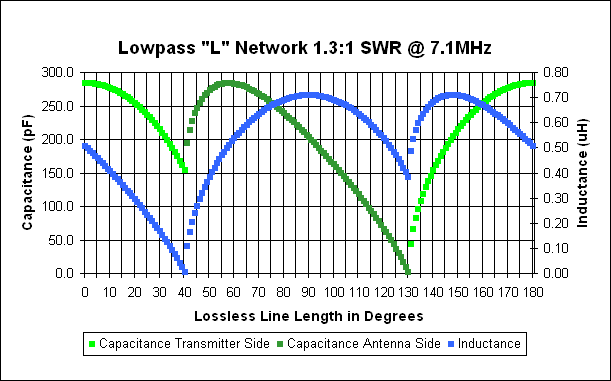
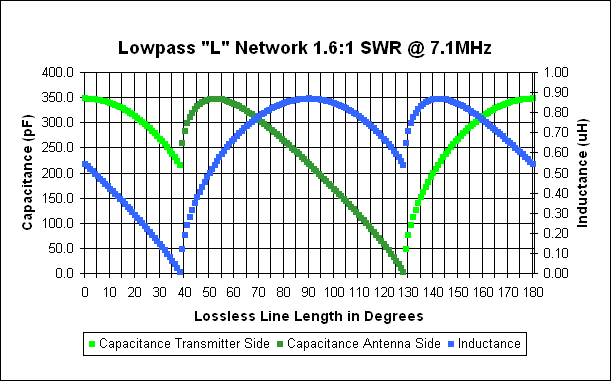


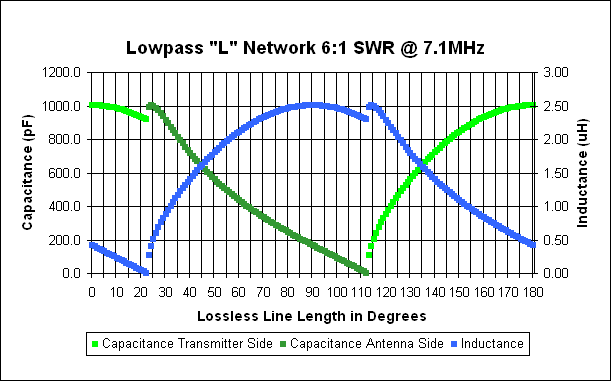
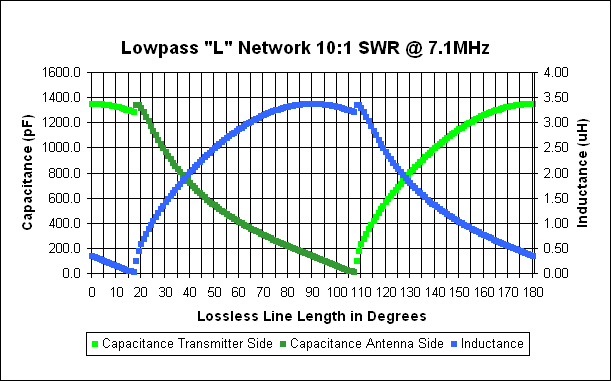
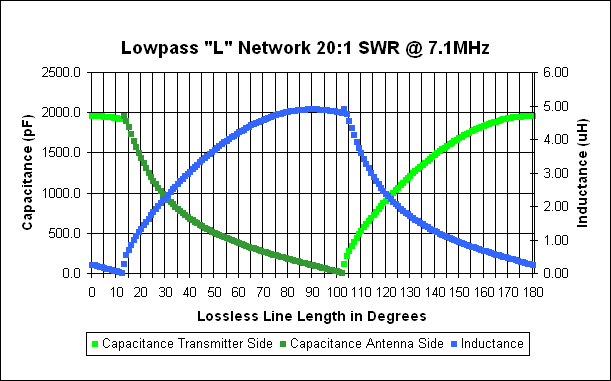
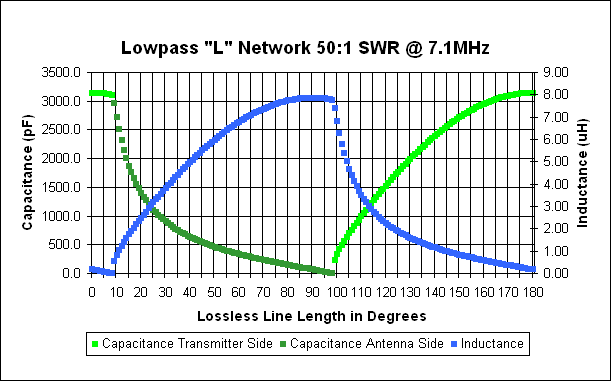
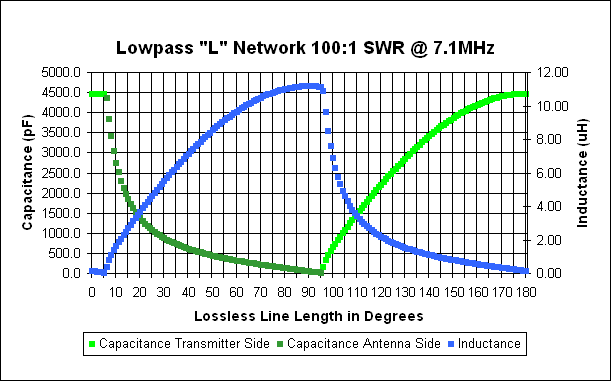
Not Complete!
